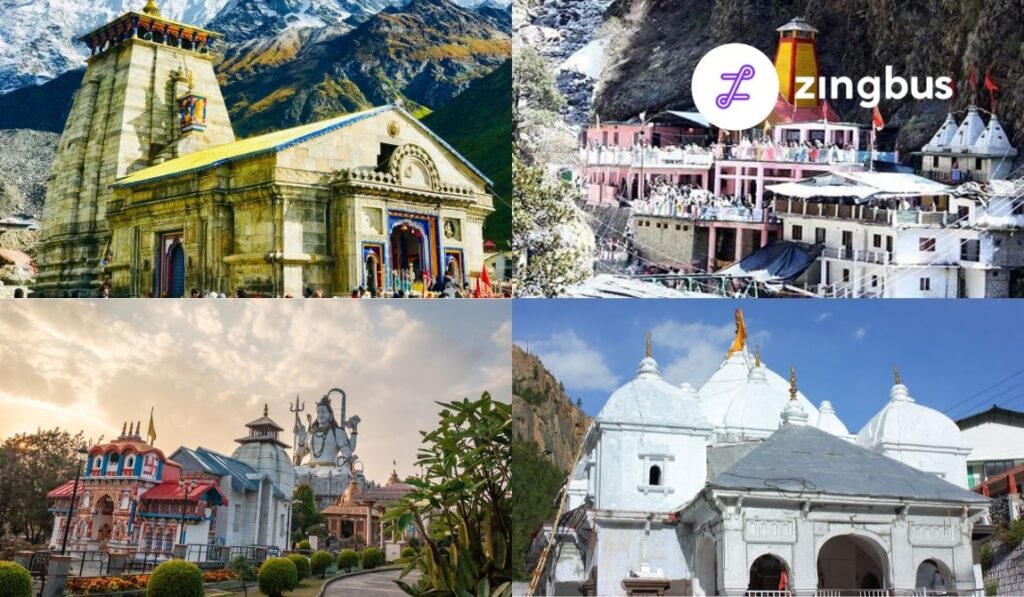The Uttarakhand Chaar Dham Yatra is perhaps one of India’s most well-known pilgrimage routes. The four most sacred locations in the Indian Himalayas, known as the Char Dham, are accessible to pilgrims yearly at roughly the same time. Yamunotri, Gangotri, Kedarnath, and Badrinath are the four locations of Char Dham Yatra, and they are all found in the state of Uttarakhand. In addition to its religious significance, this pilgrimage attracts tourists powerfully since it passes through some of Uttarakhand’s most stunning mountainous areas.
Table of Contents
History of Char Dham Yatra
The Char Dham Yatra in Uttarakhand is not the first of its name, which is an interesting fact. Contrary to popular belief, the one that occurs in Uttarakhand is the Chota Char Dham Yatra, a condensed form of the Char Dham Yatra.
The original Chardham is the four holy shrines of Adi Shankaracharya, founded in the eighth century AD and placed in four distinct regions of the nation. He designated Badrinath, Puri, Rameshwaram, and Dwarka as the Chardham locations. Nevertheless, a more condensed pilgrimage route included Yamunotri, Gangotri, Kedarnath, and Badrinath in Uttarakhand, an Indian Himalayan state.
Significance of the Char Dham Yatra and Names of 4 Dham of India
In the Hindu religion, the Char Dham Yatra is of great holy significance. Every Hindu should make this trip at least once during his lifetime, according to traditional beliefs. This is due to the notion that the Chardham Yatra opens the doors to salvation by atoning for a lifetime’s worth of sins. Furthermore, it is stated that a pilgrim achieves complete peace of mind after completing the Char Dham Yatra.
#1. Yamunotri Temple
The goddess Yamuna is honoured at the Yamunotri Temple. You should notice that the temple’s primary deity is carved out of black marble. Maharani Gularia of Jaipur constructed the current temple in the 19th century after the earlier one was destroyed by weather. On the left side of the Yamuna River, Maharaja Pratap Shah of Tehri Garhwal first erected the Yamunotri shrine.
#2. Gangotri Dham
Hindu mythology holds that King Bhagirath’s reward for his penance, Shivji, led to the birth of the Ganga. Shivji caught Ganga in her hair because of her dominance and the fact that the ground would be destroyed if she dropped hard.
The spot where Ganga initially came to earth in the shape of a river is marked with a holy stone close to Gangotri Temple. Therefore, Ganga is also known as Bhagirathi (i.e., daughter of Bhagirath).
Amar Singh Thapa, a Gorkha commander, built the Gangotri Temple in its current shape in the 18th century. The Gaumukh Glacier is thought to have been present here when the current temple was built, but it has since retreated to its current site due to climate change and global warming.
#3. Temple of Kedarnath
Kedarnath, devoted to the manifestations of Shivii, is called for King Kedar, a king of the Satya Yuga. In the Mahabharata, Shivji allegedly repented to the Pandavas for killing their own Kaurava cousins.
Even the history of the city and its temple is intriguing. The Puranas state that the Pandava brothers engaged in to appease Shivji, Kedarnath practiced extreme austerities.
The current temple was established by Adi Shankaracharya, although the Pandavas built the original temple. Adi Shankaracharya’s Samadhi is visible directly behind the temple.
#4. Badrinath Temple
Adi Shankaracharya, who discovered the Badrinarayan idol in the Alakananda River, erected the first Badrinath Temple. He was responsible for moving the shrine to Tapt Kund. Unfortunately, a new temple must be constructed because of the natural deterioration caused by time.
The ruler of Garhwal constructed the current temple in the 16th century. At first glance, the pillar designs, stunning diamonds, and traditional carving are magnificent! The structure resembles the Vihara Buddhist Temple in terms of appearance.
Shivji meditated here during the Satya Yuga for countless years as the goddess Lakshmi threw a shadow over him in the shape of a Badri tree. So, Badrinath is the reason behind the place’s name!
Shivji would reside in the entire valley that surrounds Kedar-Badri. This is the reason why, when Mahashivratri is celebrated with much grandeur, Badrinath becomes a fixture.
Make Your Char Dham Yatra Memorable with Zingbus Maxx
Have you read the blogs and considered where I would get the car for it and how I would manage the budget? Well! Who has told you that a road trip can only be made through a car?
Taking a bus will cost you far less than renting a car, along with full comfort and fun. Zingbus offers you several discounts on your first booking. Also, you may install the zingbus app to take advantage of additional benefits.
Our buses are clean and offer complete luxury and comfort with FREE wifi, blankets, water bottles, and entertainment/TV. You can make your booking as per your requirements. Let’s plan your 4-Dham yatra with Zingbus. Get your bus ticket bookings done online now!

Leave a Reply Cancel reply